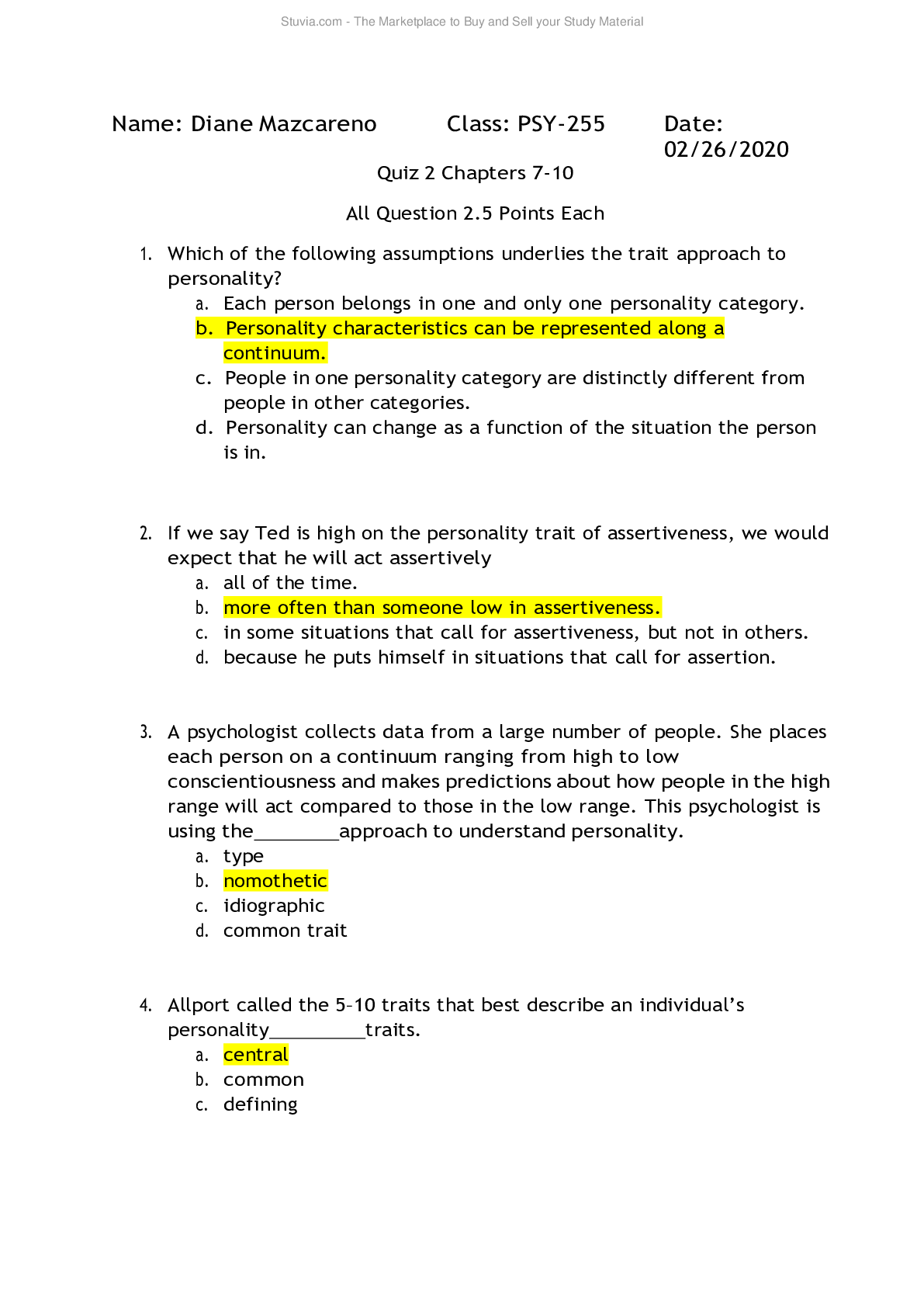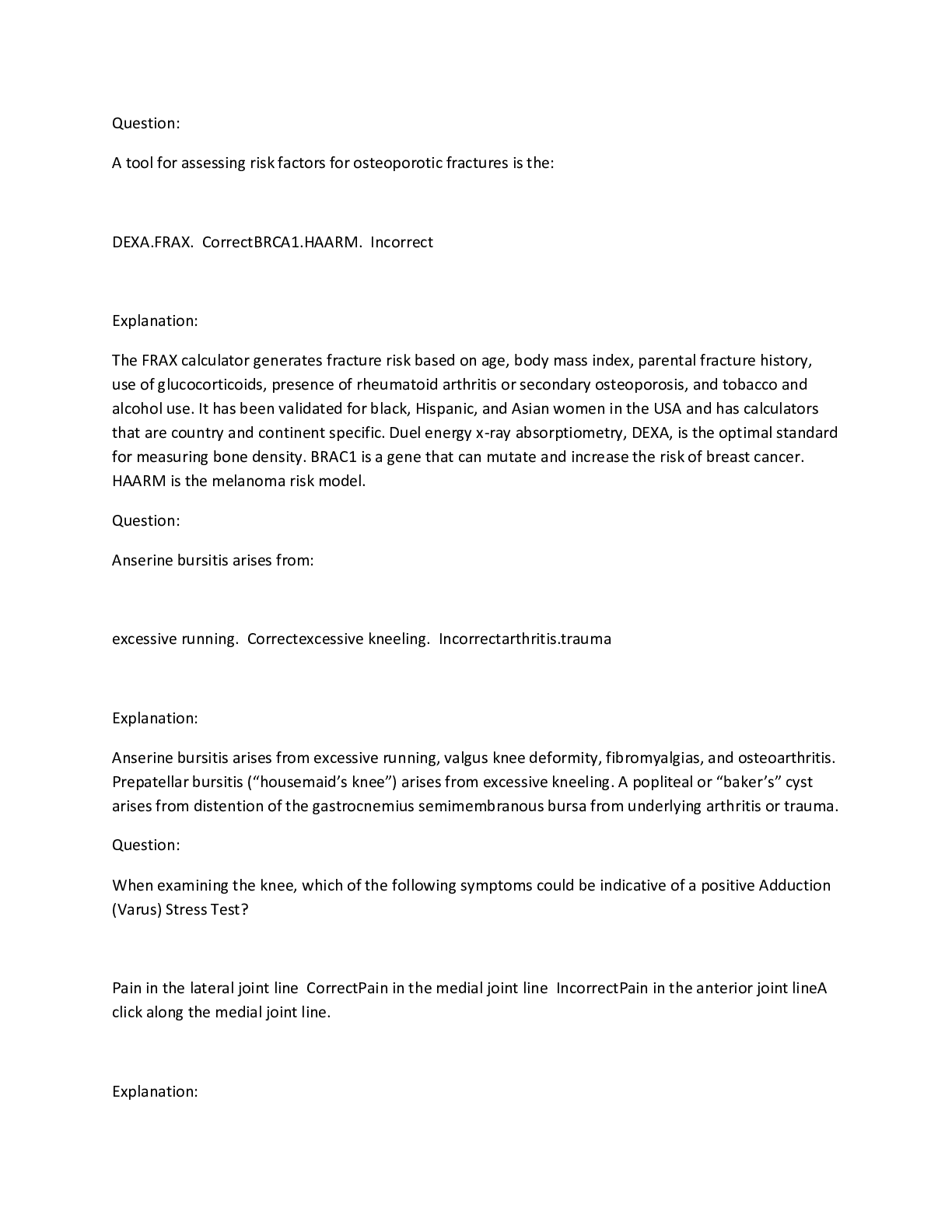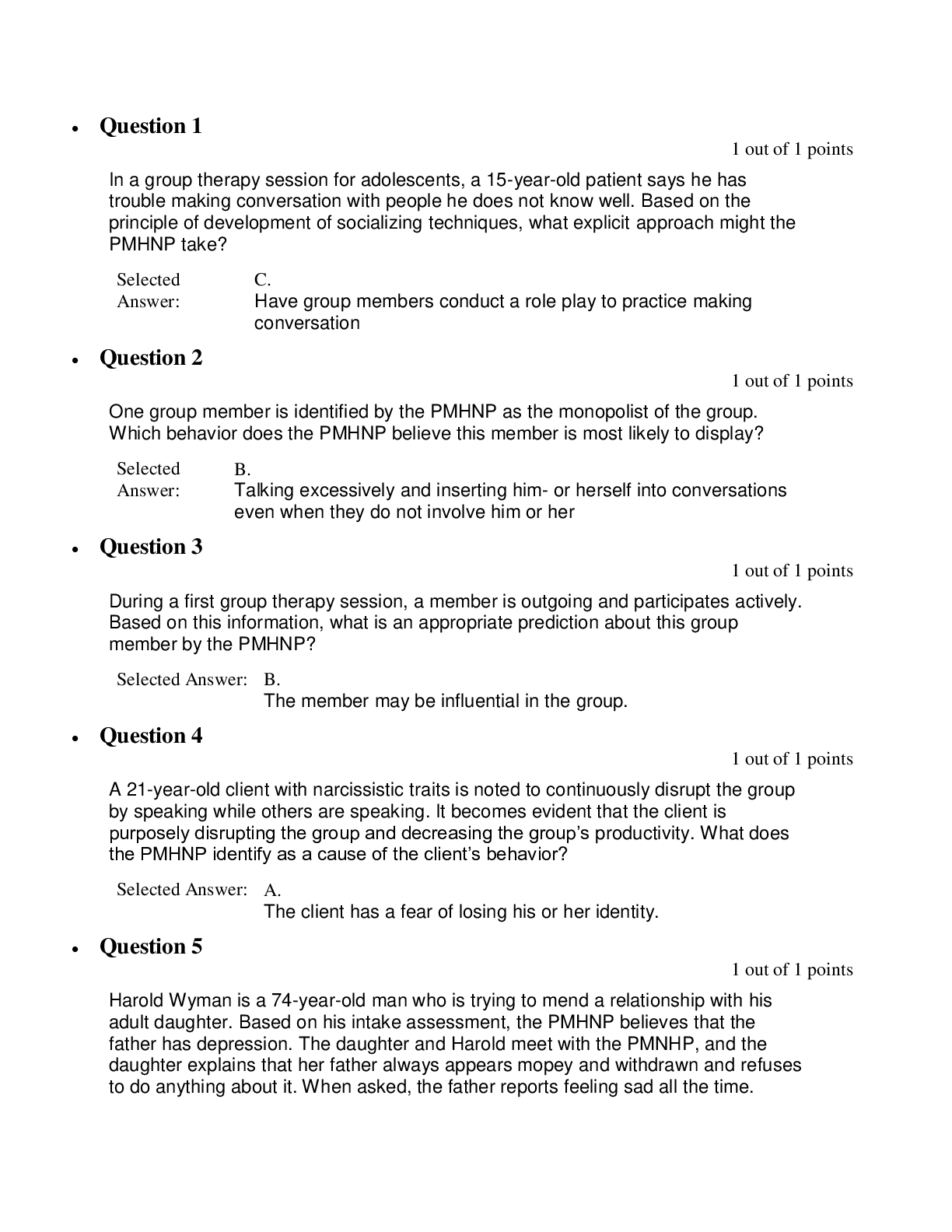Psychology > EXAM > Grand Canyon University > PSY 255 QUIZ 2 QUESTION AND ANSWERS complete exam solution (All)
Grand Canyon University > PSY 255 QUIZ 2 QUESTION AND ANSWERS complete exam solution
Document Content and Description Below
Which of the following assumptions underlies the trait approach to personality? a. Each person belongs in one and only one personality category. b. Personality characteristics can be represented along... a continuum. c. People in one personality category are distinctly different from people in other categories. d. Personality can change as a function of the situation the person is in. 2. If we say Ted is high on the personality trait of assertiveness, we would expect that he will act assertively a. all of the time. b. more often than someone low in assertiveness. c. in some situations that call for assertiveness, but not in others. d. because he puts himself in situations that call for assertion. 3. A psychologist collects data from a large number of people. She places each person on a continuum ranging from high to low conscientiousness and makes predictions about how people in the high range will act compared to those in the low range. This psychologist is using the ________ approach to understand personality. a. type b. nomothetic c. idiographic d. common trait 4. Allport called the 5–10 traits that best describe an individual’s personality _________ traits. a. central b. common c. defining d. secondary 5. One of Henry Murray’s chief contributions to the field of personality psychology was the development of the ________. a. Minnesota Multiphasic Personality Inventory b. Thematic Apperception Test c. 16-PF (16 personality factors) d. Rorschach Inkblot Test 6. In his quest to understand the basic structure of personality, Cattell relied heavily on a. the idiographic approach. b. factor analysis. c. the examination of central traits. d. case studies. 7. Karen always approaches tasks in an organized, faithful manner. She persists at a difficult job longer than most people and generally accomplishes more. Karen is probably high in which of the Big Five traits? a. Agreeableness b. Openness c. Conscientiousness d. Extraversion 8. Alicia has an active imagination and a strong intellectual curiosity. She likes new ideas and unconventional ways of looking at problems. Alicia is probably high in the Big Five trait called a. agreeableness. b. neuroticism. c. conscientiousness. d. openness. 9. Among the Big Five personality dimensions, individual differences in _________ typically are the best predictors of job performance. a. Extraversion b. Openness c. Agreeableness d. Conscientiousness 10. Psychologists often use personality traits to predict behavior in the workplace. This research has benefited recently by looking at a. the Big Five personality dimensions. b. psychogenic needs. c. central traits. d. the idiographic approach. 11. Test-takers who “fake good” a. are able to fool most test givers with their inaccurate responses. b. are not likely to be detected unless they admit that they are faking their test answers. c. are trying to present a better image than is accurate. d. are not aware that they are distorting their responses to create a false image. 12. One strength of the trait approach to personality is that it a. predicts behavior in many situations. b. is not necessary to job counselors to do their work. c. does not rely on intuition but instead on objective measures. d. explains the development of personality traits. 13. A psychologist asks you to look at some pictures and tell a story about the people in them. Which test are you probably taking? a. Minnesota Multiphasic Personality Inventory (MMPI) b. Picture Description Test (PDT) c. Rorschach test d. Thematic Apperception Test (TAT) 14. Research sometimes finds that high need for Achievement people are ineffective when placed in positions of great responsibility. Researchers say this is probably because these people a. become “burnt-out” in the climb to this position. b. have difficulty delegating authority and relying on subordinates. c. have failed to develop other personality characteristics that might make them effective leaders. d. lose motivation once they reach their goal. 15. Research on achievement and gender finds that men and women often differ in a. how much they want to succeed. b. how they define success. c. the length of time it takes them to succeed. d. how long they persist in the face of setbacks. 16. Cross-cultural researchers investigating achievement motivation find a. individualistic cultures achieve more than collectivist cultures. b. cultures that emphasize group performance tend to achieve more. c. similar levels of need for Achievement in almost all cultures. d. the meaning of achievement varies as a function of culture. 17. According to an attribution analysis of achievement behavior, first-year student Arnold is most likely to improve his academic performance if he attributes poor freshman grades to a. his ability. b. the difficulty of college classes. c. his level of effort. d. inadequate preparation for college. 18. Marisol is highly motivated to do well in her math class. Satisfaction for her comes from the feeling of proficiency she has when she understands difficult material. Researchers would say that Marisol is motivated by a. a high need for Achievement. b. a need for recognition. c. mastery goals. d. performance goals. 19. On what kind of an achievement task is a Type A person likely to work harder on than a person who is Type B? a. On virtually every kind of achievement task b. On tasks with visible extrinsic rewards, such as money c. On relatively easy tasks, even when there is no challenge d. When in competition with another person 20. Valerie is interviewing for a job she really wants. However, she also suffers from a high level of social anxiety. During the 30-minute interview, the interviewer twice pauses for several seconds before commenting on what Valerie has said. Based on research findings, how would we expect Valerie to respond to the silence? a. She enjoys the few moments in which there is no social interaction. b. She says something to keep the conversation going. c. She interprets the silence as a sign the interview is not going well. d. She uses the time to prepare what she wants to say next. 21. The strength or degree to which a person typically experiences his or her emotions is called a. emotional stability. b. affective intensity. c. valence lability. d. cognitive expressiveness. 22. A woman likes to spend her time with others, enjoys loud music, often acts impulsively, and does not like to be alone. According to Eysenck’s model of personality, this woman is a. sociable. b. highly extraverted. c. low in neuroticism. d. impulsive. 23. Which of the following was the latest “supertrait” proposed by Hans Eysenck in his theory of personality? a. Sociability b. Impulsiveness c. Optimism d. Psychoticism 24. Cross-cultural research on Eysenck’s model of personality tends to find the same three dimensions of personality across cultures. Eysenck points to this finding as evidence for a. a biological basis of personality. b. the importance of environmental influences on personality. c. evolutionary personality theory. d. the need for factor analysis. 25. According to Eysenck’s original model, which of the following is true about those high in the trait of extraversion? a. They generally have a high level of cortical arousal. b. They have learned through early experiences to enjoy social events. c. They generally have a low level of cortical arousal. d. They are low in neuroticism. 26. In contrast to Eysenck’s original theory, biological research has suggested that extraverts and introverts differ in terms of their a. level of cortical arousal. b. impulsiveness. c. sensitivity to stimulation. d. ability to concentrate. 27. According to temperament researchers, which statement is correct about inhibited children? a. They will grow up to be shy adults. b. They are born with a predisposed tendency for anxiety to novelty. c. At least half of all American children can be identified as “inhibited.” d. They cannot be identified until about the age of five. 28. According to evolutionary personality theory, psychological mechanisms a. evolved because they were needed for survival. b. helped the species survive and reproduce. c. are identical in all people. d. were once useful, but no longer are. 29. Research indicates that a child’s temperament is related to how well he or she performs in school. Researchers explain this finding with each of the following reasons EXCEPT one. Which one? a. Temperament is related to intelligence. b. Teachers may be more willing to work with students of certain temperament. c. Some temperaments are more compatible with the requirements of the typical classroom than others. d. Teachers sometimes misinterpret temperamental differences in their students. 30. Research on the academic performance of elementary school children has found that a. temperament is not related to academic performance. b. children with an “easy” temperament don’t do as well in school as other children. c. students do better when their temperament is similar to that of the teacher. d. temperament plays a role in how well children do in school 31. Using the electroencephalograph (EEG), researchers have found higher activation in the left hemisphere is associated with a. smiling. b. negative mood. c. greater reactions to films that elicit fear. d. feelings of disgust. 32. For many years, psychologists debated the question of “nature versus nurture” in an “either/or” fashion. In what way has that question changed for today’s personality psychologists? a. Which determines personality—genetics or the environment? b. Which is more important in determining personality—genetics or the environment? c. To what extent are our personalities influenced by genetics? d. To what extent and how do both genetics and the environment influence personality? 33. Psychologists interested in studying personality might use the twin-study method in order to a. separate environmental from genetic influences. b. determine how much of our personality is inherited from our parents. c. determine how much of our personality is the result of experience. d. all of these are correct. 34. Personality researchers sometimes examine the personalities of children who were adopted shortly after birth. They do this because a. these children were likely raised in a very supportive, nurturing environment. b. genetic and environmental influences are not confounded like they are when examining children raised by their biological parents. c. extensive records of the child’s health and early personality indicators are available. d. the researchers want to know if adoption is traumatic for the children. 35. A researcher using the twin-study method finds an average correlation of .50 between monozygotic twins’ scores on a measure of self-esteem. The researcher finds an average correlation of .30 between dizygotic twins’ scores on this measure. The difference between the size of the correlations is statistically significant. What conclusion might the researcher draw from these results? a. Genetics has more of an influence on self-esteem than environment has. b. There is evidence for a genetic influence on self-esteem. c. There is no evidence for a genetic influence on self-esteem. d. The results are opposite of what would be expected if there were a genetic influence on self-esteem. 36. One problem with adoption studies is that the homes in which twins are placed a. are so very different that comparisons cannot be made. b. are often very similar because adoptive families are similar in important ways. c. are highly specialized for adoptive parenting. d. allow the same genetic influences to emerge. 37. Research on extraversion introversion has found a. consistent evidence for a genetic component to extraversion introversion. b. some evidence for a genetic component to extraversion introversion but a significant amount of research that disputes this. c. almost no evidence for a genetic component to extraversion introversion. d. consistent evidence arguing against a genetic component to extraversion introversion. 38. For extraverts, friends often serve as an important buffer against stress. This finding supports the idea that extraverts a. are generally more anxious than introverts. b. often find interacting with friends an unpleasant experience. c. are less sensitive to information about rewards than introverts. d. have higher positive affect due to greater social activity. 39. According to evolutionary personality theory, men and women base their choice of romantic partners in part on concerns for “parental investment.” This means we a. want the parents of our spouses to be involved in the raising of our children. b. select mates who are likely to contribute to successful reproduction and child-raising. c. consider what the parents of our potential partners are like because personality is partly inherited from one’s parents. d. prefer partners for whom both parents were actively involved with their children. [Show More]
Last updated: 2 years ago
Preview 1 out of 10 pages

Buy this document to get the full access instantly
Instant Download Access after purchase
Buy NowInstant download
We Accept:

Reviews( 0 )
$10.00
Can't find what you want? Try our AI powered Search
Document information
Connected school, study & course
About the document
Uploaded On
Jun 09, 2021
Number of pages
10
Written in
Additional information
This document has been written for:
Uploaded
Jun 09, 2021
Downloads
0
Views
60


.png)




















